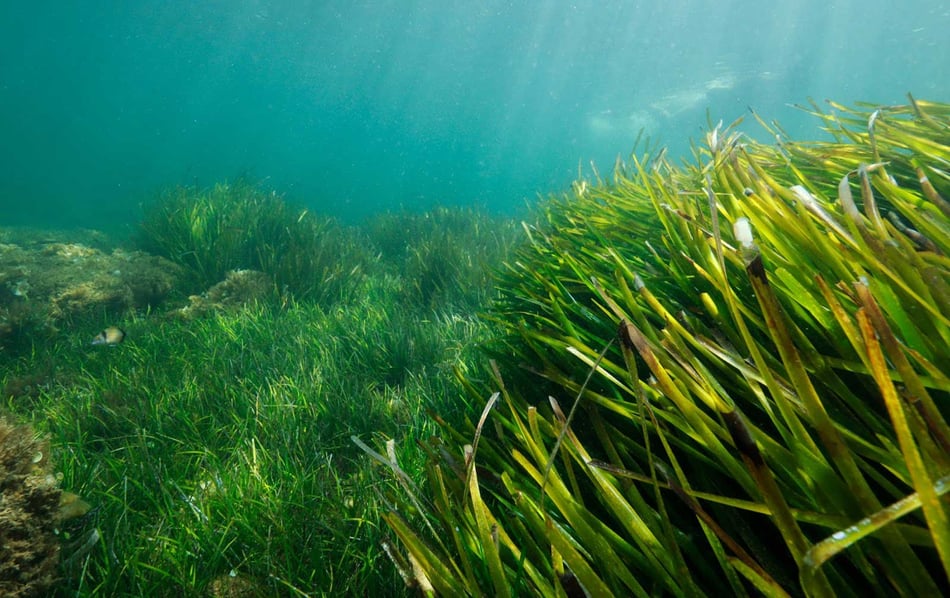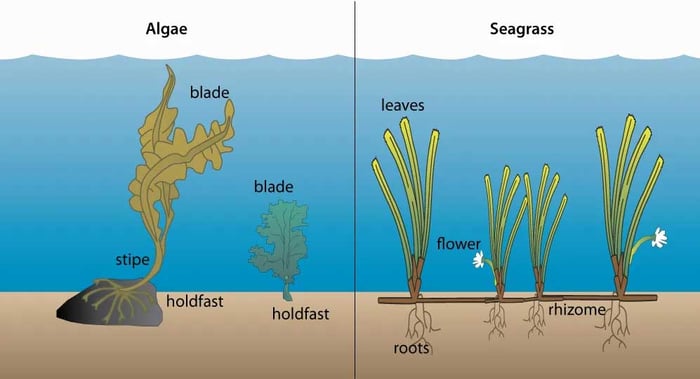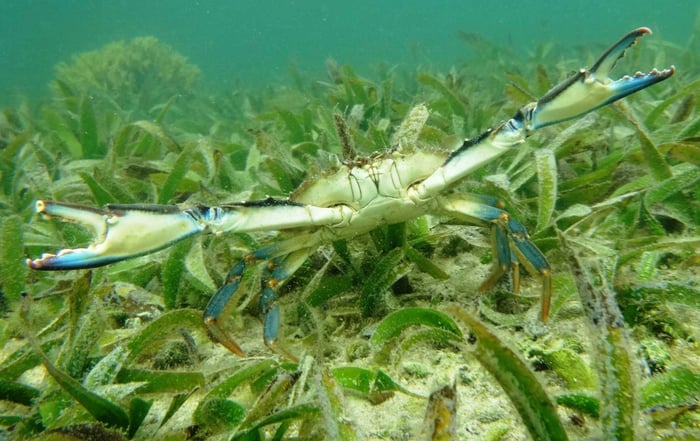The Underwater Lungs of the World: Seagrass Meadows

Tin
4
min. read

Marine ecosystems, the lifeblood of our blue planet, are vast, mysterious, and teeming with life. Covering more than 70% of Earth's surface, these watery realms comprise a delicate balance of flora and fauna, each with its specific role in maintaining biodiversity and ecological equilibrium.
Enter the seagrass meadows. These aren't the tall grasses you might imagine swaying in the wind on a field. Seagrass meadows are underwater gardens found along coastlines, bays, and other shallow waters of our oceans.
Home to a diverse array of marine life, they serve as nurseries for many fish species and act as natural water filters, cleaning our seas from harmful pollutants. These meadows are an essential, yet often overlooked, component of our marine ecosystem.
What is Seagrass?

Photo taken from Smithsonian article on Algae versus Seagrass
Contrary to what its name may suggest, seagrass is not a type of algae seaweed; rather, it is a marine plant. Originating from terrestrial plants that adapted to life underwater, seagrasses form some of the only flowering plant communities in the ocean.
These plants are complete with leaves, roots, and flowers. Unlike seaweeds, which are algae and lack a root system, seagrasses anchor themselves in the sandy or muddy bottoms of shallow waters with a robust root structure. They play a vital role in maintaining water quality by absorbing excess nutrients and releasing oxygen through photosynthesis, just like their terrestrial counterparts.
Seagrasses aren't a one-size-fits-all category; they come in a variety of types and species, each with unique features and ecological roles. There are approximately 60 different species of seagrass worldwide, each adapted to specific conditions ranging from salinity levels to water depth and temperature.

Some well-known types include Shoalgrass, Turtle Grass native to the Caribbean, and Posidonia which is indigenous to the Mediterranean. Each of these seagrasses offers distinct habitats for marine life, varying in leaf density, length, and root complexity.
Importance of Seagrass Meadows to Marine Life
Nursery Role
Seagrass meadows serve as crucial nurseries for a plethora of marine species, including those that are commercially important like shrimp, crab, and various types of fish.

These underwater meadows offer a protective environment for juvenile organisms, providing them with ample hiding spots from predators within their dense leaves.
The root systems of seagrasses stabilize the seabed, making it a fertile ground for laying eggs and for invertebrates to burrow. This nurturing role ensures a higher survival rate for young marine life, which consequently contributes to robust adult populations, helping both the ecosystem and the fishing industry.
Oxygen Production
Seagrass anchors dynamic systems that actively contribute to ocean health. Through the process of photosynthesis, they produce a significant portion of the ocean's oxygen. This oxygen production is vital not only for the immediate marine environment but also for the planet as a whole, given the ocean's role as a primary producer of Earth’s oxygen.
Carbon Sequestration
Seagrass is remarkably efficient at capturing and storing carbon from the atmosphere, in a process known as carbon sequestration. One square meter of seagrass can sequester up to twice the amount of carbon as a square meter of rainforest. The deep roots and rhizomes of seagrasses store carbon in the soil for long periods, sometimes for thousands of years, thereby preventing its release back into the atmosphere.
Biodiversity Hotspot
Seagrass meadows are veritable hotspots of biodiversity, providing habitat to a wide array of marine life—from microscopic organisms to large marine mammals like dugongs and manatees. They serve as feeding grounds for many species and as resting places for migratory birds.
The rich biodiversity within these meadows contributes to their resilience and makes them a critical component of the marine ecosystem. The health of seagrass meadows is, therefore, an indicator of the overall health of the marine environment.
Championing the Lungs of Our Oceans
Seagrass meadows, often hailed as the 'lungs of our oceans,' are far more than just underwater landscapes. They are vital ecosystems teeming with life, playing pivotal roles from acting as nurseries for marine species, biodiversity hotspots and carbon capturers.
Their loss would not only jeopardize marine biodiversity but would ripple through the entire ecological chain, affecting us all. Conserving and restoring these invaluable meadows is no longer an option—it's an imperative.
Their loss would not only jeopardize marine biodiversity but would ripple through the entire ecological chain, affecting us all. Conserving and restoring these invaluable meadows is no longer an option—it's an imperative.
We all have a role to play. By supporting marine conservation efforts, you're not just protecting seagrass; you're championing a healthier, more balanced planet.
Together, we can ensure that these marine treasures thrive for generations to come.
At IMARCS, we are deeply committed to preserving and restoring vital marine habitats - whether rooted in seagrass, coral, or giant clams. Our mission and vision align with the principles of sustainability and harmony that seagrass meadows and marine reefs exemplify in spades.
Together we can make a real, positive, and measurable impact on our beloved planet.
References:
Cullen-Unsworth, L. C., Jones, B. L., Lilley, R., & Unsworth, R. K. F. (2018). Secret Gardens Under the Sea: What are Seagrass Meadows and Why are They Important? Frontiers for Young Minds, 6. https://doi.org/10.3389/frym.2018.00002
Five ways often-unheralded seagrasses boost biodiversity. (2023, March 1). UNEP; United Nations Environment Programme. https://www.unep.org/news-and-stories/story/five-ways-often-unheralded-seagrasses-boost-biodiversity
Jiang, Z., Huang, D., Fang, Y., Cui, L., Zhao, C., Liu, S., Wu, Y., Chen, Q., Ranvilage, C. I. P. M., He, J., & Huang, X. (2020). Home for marine species: Seagrass leaves as vital spawning grounds and food source. Frontiers in Marine Science, 7. https://doi.org/10.3389/fmars.2020.00194
Ocean, S. (2013, February 27). Seagrass and seagrass beds. Smithsonian Ocean; Smithsonian’s National Museum of Natural History. https://ocean.si.edu/ocean-life/plants-algae/seagrass-and-seagrass-beds
Rankine, H. (2023, January 10). What is Posidonia seagrass? Yachting Pages. https://www.yachting-pages.com/articles/what-is-posidonia-seagrass.html
Seagrass types. (2016, December 12). Texas.gov. https://tpwd.texas.gov/landwater/water/habitats/seagrass/seagrass-types
Seagrasses. (n.d.). National Wildlife Federation. Retrieved September 7, 2023, from https://www.nwf.org/Educational-Resources/Wildlife-Guide/Plants-and-Fungi/Seagrasses
Seagrasses can store as much carbon as forests. (n.d.). Nsf.gov. Retrieved September 5, 2023, from https://www.nsf.gov/news/news_summ.jsp?cntn_id=124263
Why are sea turtles important — SEE turtles —. (n.d.). SEE Turtles. Retrieved September 4, 2023, from https://www.seeturtles.org/why-are-sea-turtles-important
Why Oceans Need Sea Turtles: The Importance of Sea Turtles in Marine Ecosystems. (n.d.). Oceana.org. Retrieved September 4, 2023, from https://oceana.org/wp-content/uploads/sites/18/Why_Healthy_Oceans_Need_Sea_Turtles.pdf